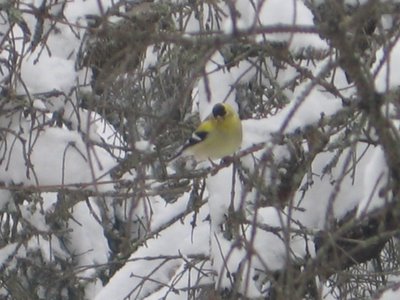
After teasing and taunting me all morning as he came and went with his flock, this very yellow American goldfinch finally paused long enough for me to get a decent photo. See my previous post for background information on this unusually colored (for winter) bird.
I've been thinking about possible explanations why this male did not molt to olive drab like most of the flock (there are a few individuals with varying degrees of yellow; this one is the most striking). Either he, for some reason, did not molt completely in the fall, or perhaps something caused him to start molting early. I had not noticed a goldfinch with a black forehead patch before yesterday, although I've had an unusual amount of time to sit and look at the bird feeder this week, so maybe it's the result of more observations. But if it were a molting issue, I would think maybe the yellow would be far more patchy. The normal time for males to begin their spring molt to yellow is around mid March here.
Or it could be an odd genetic trait; maybe this fellow's feathers just do not know how to be dull in color. That would put him at a disadvantage with predators, as his bright color contrasts with the muted colors of winter.
In other feeder observations, I observed Common redpolls at the feeder for the first time this winter, although they've been reported elsewhere locally. And very briefly a female Evening grosbeak came to the feeder. I've seen small flocks of them, but this is the first one at the feeder.
Lest you think I've come upon some fortune and now have nothing to do with myself but sit and watch birds all day (don't I wish), Calvin has been feeling under the weather so I am staying home with him and Mr. Attitude. I may be getting the bug myself, but at least I don't have to go out and do chores tonight!
9 comments:
That's one pretty little bird. We get some kind of yellow finch here, too, but I've never been able to see one close enough to really identify it for sure. I'm so near-sighted! They like the carragana bushes a lot, and there's certainly no shortage of carragana on the prairie.
Pretty bird. These guys mass at my parent's backyard feeder in St. Augustine earlier in the season. They are always so pleased to see them take over the feeder. Apparently they consume huge amounts of feed, because I always get a report about how many times they had to refill the feeder.
They are such bright and pretty little birds. We found that they absolutely LOVE Nyger seed. Put up a special nyger seed feeder and you will be inundated with yellow finches. We tried it and actually took the feeder down because there were just so many of them, and they knocked the seed all over the place!
Hope you and the kids are feeling better.
MCM, I used to stubbornly ignore birds because they wouldn't sit still while I ID'd them, but then I discovered that a musician's ear is a great tool for birding. This recording doesn't sound quite as I recall goldfinches around here, but there is a note about two-thirds through the recording that is very distinctive and just like I recall. Also, goldfinches have a wonderful dipping flight accompanied by what seem to be chirps of joy just to be flying.
Deb, thanks for this! Here where we never see them in winter, it hadn't even occurred to me that goldfinches molt. And I was frustrated by eclipse plumage in ducks!
Cool picture Deb. I think you should get this into the next I and the Bird. Maybe some of those folks will have something to add...
That's a good idea, troutgrrrl. This is the most "birdy" thing I've posted for some time, and I'd be interested in hearing others' observations.
I had a listen, Laura, and it does sound familiar. I need to sharpen my ears as well as my eyes, I think.
It was fun to see your post listed in the I and the Bird, Deb. :) Great one!
I've been watching a flock of drab olive finches at my feeder this winter. I tried and tried to identify them without luck. I thought they looked like Goldfinches but were too drab. Finally ran across some info that explained the color change!! Glad to know! Enjoyed your pic
Post a Comment